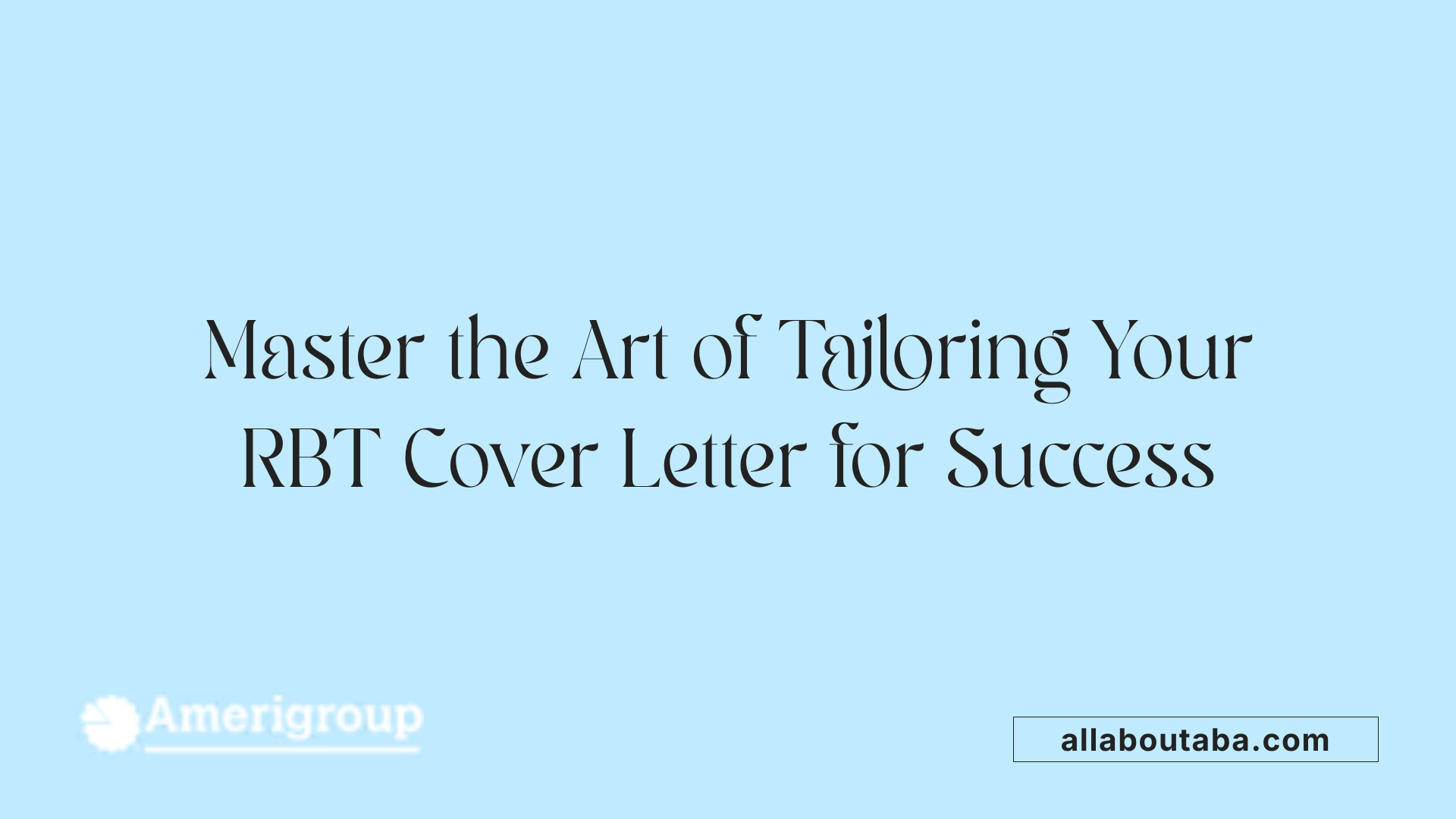Understanding the Significance of a Strong Cover Letter for RBT Roles
A well-crafted cover letter is a crucial component of the application process for a Registered Behavior Technician (RBT) position. It offers a unique opportunity to introduce yourself, showcase your relevant skills, and demonstrate your understanding of the role and its responsibilities. Given the competitive nature of behavioral health jobs, tailoring your cover letter to reflect your qualifications and enthusiasm can significantly boost your chances of securing an interview.
Key Components of an Effective RBT Cover Letter
What are the key components and structure of an effective cover letter for a Registered Behavior Technician (RBT) position?
A well-written cover letter for an RBT role should be structured to clearly showcase your qualifications, enthusiasm, and understanding of the position. It starts with a professional header that includes your contact information and the employer’s details.
Next, you should include a personalized greeting directed specifically to the hiring manager. This personal touch demonstrates your effort to connect directly with the organization.
The opening paragraph needs to be engaging and expressive of your genuine interest in the role. Briefly mention how you learned about the position and why you are passionate about working with individuals with special needs, especially those with Autism Spectrum Disorder.
In the body of the letter, highlight your relevant certifications, education, and practical experience with ABA principles. Use specific examples that demonstrate your ability to apply ABA techniques, such as data collection, behavior intervention, and collaboartion with supervisors and clients.
Don’t forget to showcase soft skills like patience, empathy, and strong communication abilities. Provide tangible examples that illustrate these qualities in action.
It’s important to articulate your understanding of RBT responsibilities, including executing treatment plans, collecting and analyzing data, and maintaining ethical standards. Align your goals with the organization’s mission and values to establish a connection.
The closing paragraph should be concise and include a call to action, encouraging the employer to contact you for an interview. Make sure to include your contact details and express appreciation for considering your application.
By ensuring your cover letter includes these elements, you position yourself as a qualified and dedicated candidate suitable for the RBT role. Tailoring your letter to each organization by researching their specific needs enhances your chances of making a memorable impression.
Personalizing Your Cover Letter for Impact
 When applying for an RBT position, crafting a customized cover letter can significantly boost your chances of standing out. First, it’s essential to research the organization thoroughly. Understanding their core values, methods, and approach to behavioral therapy allows you to tailor your message to resonate with their mission.
When applying for an RBT position, crafting a customized cover letter can significantly boost your chances of standing out. First, it’s essential to research the organization thoroughly. Understanding their core values, methods, and approach to behavioral therapy allows you to tailor your message to resonate with their mission.
Begin your cover letter by addressing it to the specific hiring manager, if possible. Personalization demonstrates attention to detail and respect for the organization’s process.
In the body of your letter, highlight your relevant skills and experiences that align with the job description. For example, mention your hands-on experience with ABA techniques, implementing behavior intervention plans, conducting data collection, and collaborating with clients and supervisors. If you possess certifications like the RBT credential, be sure to include this to reinforce your qualifications.
Express your enthusiasm for working with individuals with ASD and your dedication to making a positive impact through behavioral therapy. Show genuine passion for helping those with developmental disorders, and connect your personal and professional goals to the organization’s mission.
To make your cover letter more compelling, discuss how your background and skills can contribute to the organization’s success. For instance, you might share a brief story about a positive outcome you facilitated or a particular skill that sets you apart.
Finally, conclude your letter with a clear call to action, such as expressing your eagerness to discuss how you can contribute to their team, and include your contact information.
Remember: Tailoring your cover letter isn’t just about listing your skills; it’s about making a connection with the employer and demonstrating that you understand their values and needs.
For more tips on customizing an RBT cover letter, consider searching with queries like "Tips for customizing an RBT cover letter" to find detailed advice and sample templates.
Demonstrating Skills and Lessons from Experience

What should I include in an RBT cover letter to demonstrate my understanding of the role's responsibilities and requirements?
A well-crafted cover letter for an RBT (Registered Behavior Technician) position should clearly highlight your familiarity with core responsibilities such as implementing behavior intervention plans, collecting and analyzing data, and working collaboratively with clients, families, and supervisors.
To effectively showcase your understanding, provide concrete examples from your experience that demonstrate how you have applied ABA principles in real-world settings. For instance, mention specific strategies you have used to manage behaviors or facilitate learning, and describe how you have tracked client progress over time.
It's crucial to emphasize your knowledge of the responsibilities involved in the role, including executing interventions accurately and maintaining ethical standards. Highlighting your soft skills—such as patience, empathy, and effective communication—is equally important, as these qualities greatly impact client success.
In addition, sharing examples of successful client outcomes or progress tracking provides tangible proof of your capabilities. For example, you might describe a situation where your intervention led to improved communication skills or reduced problematic behaviors in a client.
Furthermore, demonstrating how you collaborate with families and team members shows your team spirit and dedication to comprehensive care. Describe any experience working with multidisciplinary teams or involving families in treatment plans.
Ultimately, a compelling cover letter connects your practical skills and lessons learned with your enthusiasm for supporting individuals with developmental challenges. Incorporating specific examples and emphasizing your ABA knowledge will make your application stand out and show that you are prepared to excel as an RBT.
The Role of Passion and Motivation in Your Cover Letter

Why is passion important to highlight in an RBT cover letter?
Expressing genuine enthusiasm and a commitment to helping individuals with Autism Spectrum Disorder (ASD) can significantly distinguish you from other applicants. When you demonstrate a heartfelt dedication to the field, it shows potential employers that you are not just looking for a job, but are truly motivated to make a difference in clients' lives. This kind of passion can resonate with hiring managers, making your application more memorable.
In your cover letter, share why you are drawn to behavioral therapy and working with individuals with ASD. Personal stories, such as experiences that sparked your interest or a specific moment that inspired you to pursue this career, can create a compelling narrative.
Additionally, highlighting your ongoing professional development and training efforts—such as completing a 40-hour RBT training course, staying current with ABA techniques, or participating in relevant workshops—demonstrates your proactive attitude and dedication to growth in this field.
How to effectively showcase your enthusiasm and motivation
Start your cover letter with a strong introduction that communicates your excitement about the position. Mention how your background, skills, and passion align with the organization’s mission. Use specific examples to illustrate your experience with ABA techniques, data collection, and collaboration with teams.
Expressing genuine interest in continuous learning and adapting new approaches highlights your commitment to providing the best care possible. Remember to keep the tone professional, sincere, and tailored to the specific organization.
Ultimately, conveying your motivation through authentic storytelling and a clear demonstration of your ongoing efforts to develop as an RBT can leave a powerful impression, increasing your chances of landing the role.
Best Practices for Writing Your Cover Letter

What are some tips and best practices for writing a compelling cover letter for an RBT position?
A well-crafted cover letter can significantly enhance your application for a Registered Behavior Technician (RBT) role. Start by addressing the letter to the hiring manager directly; personalized greetings demonstrate your genuine interest. Use a professional and enthusiastic tone throughout to convey your passion for helping individuals with developmental disorders.
Tailor your cover letter to the specific organization by researching their values and aligning your skills and experiences accordingly. Highlight relevant experience in Applied Behavior Analysis (ABA), especially working with clients with Autism Spectrum Disorder (ASD). Detail how your background, training, and personal qualities make you a good fit for the role.
Proofreading is crucial—meticulously check for spelling and grammatical errors to maintain professionalism. Keep your cover letter concise and focused, ideally fitting it within one page. Use clear, impactful language and bullet points where appropriate to improve readability.
Conclude your cover letter with a specific call to action, such as expressing your eagerness to discuss how you can contribute to the organization and providing your contact details. Incorporating these elements can make your application stand out and showcase your genuine interest and readiness for the RBT position.
This approach ensures your cover letter not only presents your qualifications effectively but also communicates your motivation and attention to detail—qualities highly valued in behavior analysis and support roles.
Common Pitfalls to Avoid in Your Cover Letter
What are some common mistakes to avoid when writing a cover letter for an RBT position?
When applying for an RBT role, crafting a compelling cover letter is essential. However, there are several common errors that can undermine your efforts. First, avoid vague or generic statements that don't highlight your specific skills or experiences. Instead, provide concrete examples of your work with individuals with Autism Spectrum Disorder (ASD) and your familiarity with Applied Behavior Analysis (ABA).
Next, ensure you personalize each cover letter to the organization. Research the company’s values and type your letter accordingly to show genuine interest and alignment with their mission. Using a one-size-fits-all approach can make your application seem inattentive.
It's also important to stay on topic. Refrain from discussing unrelated personal interests or reasons for leaving previous jobs, unless they directly relate to your motivation for becoming an RBT or working with individuals with developmental needs.
Attention to detail matters greatly. Spelling mistakes, grammatical errors, or inconsistent formatting can leave a negative impression. Carefully proofread your letter and consider having someone else review it before submitting.
Lastly, avoid cluttered or overly lengthy formatting. Keep your cover letter concise—ideally one page—and use clear sections with bullet points or paragraphs to enhance readability.
By steering clear of these common pitfalls, you position yourself as a professional candidate who is dedicated, detail-oriented, and genuinely committed to supporting individuals with ASD through ABA techniques.
Highlighting Qualifications and Experience Effectively
 To craft a compelling cover letter for an RBT position, it is essential to clearly showcase your relevant skills, experience, and personal traits. Start by analyzing the job description carefully. Identify the specific requirements and desired qualities the employer seeks, such as experience with ABA techniques, data collection, or working with individuals with Autism Spectrum Disorder.
To craft a compelling cover letter for an RBT position, it is essential to clearly showcase your relevant skills, experience, and personal traits. Start by analyzing the job description carefully. Identify the specific requirements and desired qualities the employer seeks, such as experience with ABA techniques, data collection, or working with individuals with Autism Spectrum Disorder.
In your cover letter, include concrete examples of your work with clients. For example, describe how you have implemented behavior intervention plans, utilized data reporting to track progress, or observed positive changes in clients’ behaviors. Mention any relevant coursework or internships if you are still pursuing certification, emphasizing your ongoing commitment and foundational knowledge.
Additionally, highlight soft skills that are crucial in this role, such as patience, empathy, effective communication, and teamwork. Sharing brief anecdotes that demonstrate these traits can make your application stand out.
When addressing the question 'How can I tailor my cover letter to better highlight my qualifications and relevant experience for an RBT role?', focus on demonstrating genuine enthusiasm for helping individuals with developmental disorders. Express your understanding of ABA principles and your motivation for working in this field, aligning your goals with the organization’s mission.
A well-targeted cover letter not only showcases your technical skills but also your personal dedication and alignment with the organization’s values. This comprehensive approach provides a strong foundation to make a positive impression on potential employers.
For more guidance, search for tips on 'How to highlight experience in an RBT cover letter' to access detailed strategies and sample phrases tailored for this role.
Understanding the Certification Process and Requirements
What should I include in my cover letter to show my understanding of the RBT role's responsibilities and certification requirements?
In your cover letter, it's important to highlight your knowledge of the certification pathway for Registered Behavior Technicians (RBTs). Mention your completion of the 40-hour training based on the RBT Task List, including ethics and professional conduct. Emphasize that you've passed the required assessment and understand ongoing supervision requirements, such as providing at least 5% of your working hours under supervision with regular face-to-face contacts, which may be remote.
Express your awareness of the importance of maintaining certification through continuous supervision, adherence to ethical standards, and annual renewal processes. Demonstrating this understanding shows your commitment to upholding professional standards and your readiness to execute duties responsibly.
Minimum qualifications: age, education, background check
To qualify as an RBT, candidates must be at least 18 years old, hold a high school diploma or equivalent, and clear a criminal background check. These basic requirements ensure candidates are prepared to handle the responsibilities ethically and professionally.
40-hour training and passing an assessment
Candidates are required to complete a 40-hour training course aligned with the RBT Task List, covering topics like behavior reduction, measurement, and ethics. After training, passing a comprehensive assessment verifies competency. This process is essential for ensuring practitioners are prepared to implement ABA interventions safely.
Continuing supervision and ongoing compliance
Once certified, RBTs must receive ongoing supervision—at least 5% of their total working hours per month—comprising at least two face-to-face contacts, which can be conducted remotely. Practitioners are also required to self-report relevant conduct and maintain compliance with the Behavior Analysis Certification Board (BACB) standards to retain their credentials.
Exam structure, cost, and testing procedures
The RBT exam consists of 75 multiple-choice questions, though some sources mention 85, with a time limit of around 90 minutes. Testing is administered via Pearson VUE testing centers, ensuring a secure environment. The exam fee is $95, and preparation courses can be found at minimal or no cost.
Renewal and reactivation procedures
Certification renewal is annual and involves demonstrating ongoing competency through a renewal assessment. If an RBT becomes inactive due to lack of supervision or personal choice, reactivation requires re-establishing supervising relationships and meeting Certification standards again.
| Requirement | Details | Additional Notes |
|---|---|---|
| Age | Minimum 18 years | Must provide proof of age |
| Education | High school diploma or equivalent | Necessary for eligibility |
| Background check | Criminal background screening | Conducted before certification issuance |
| Training | 40-hour course based on RBT Task List | Includes ethics and professional conduct |
| Assessment | Pass the RBT competency assessment | Verifies practical skills |
| Supervision | 5% of hours monthly, minimum two contacts | Allows remote supervision if needed |
| Certification renewal | Annually, demonstrate ongoing competency | Complete renewal assessment |
| Exam fee | $95 | Conducted at Pearson VUE centers |
Having a clear grasp of these standards and demonstrating this knowledge in your cover letter can significantly strengthen your application, showing your dedication to professional growth and ethical practice in the ABA field.
The Role of Professional and Ethical Standards
How does understanding the role and responsibilities of an RBT inform your cover letter?
When writing a cover letter for an RBT position, showcasing your understanding of professional and ethical standards is essential. Demonstrate your knowledge of the RBT scope of practice, including implementing behavior intervention plans, collecting and analyzing data, and maintaining client confidentiality. Highlight your familiarity with the BACB's Ethics Code, emphasizing your commitment to conducting yourself professionally and ethically.
Mention your awareness of supervision requirements, such as adhering to at least 5% supervision of your working hours and maintaining clear communication with supervisors. This shows your readiness to meet ongoing standards for certification and practice.
By aligning your skills and values with these standards, you convey a strong sense of professionalism and dedication to ethical behavior in delivering quality care.
Adherence to BACB guidelines
Following the BACB's guidelines is fundamental in your role. Make sure your cover letter reflects your understanding of these protocols, such as self-reporting conduct that may impair your ability to practice safely. Demonstrating knowledge of these standards reassures employers of your commitment to responsible practice.
Reporting conduct issues
A crucial aspect of maintaining professionalism is the responsibility to report any conduct issues or personal conditions that might affect your work as an RBT. Mentioning your commitment to transparency and adherence to reporting protocols in your cover letter can reinforce your integrity.
Maintaining ongoing certification
Ongoing education and supervision are vital for RBTs. Express your enthusiasm for continuous learning and how you plan to stay updated with the latest ABA practices and ethical requirements. This shows your dedication to maintaining certification standards and providing the best possible support to clients.
| Area | Focus | Details |
|---|---|---|
| BACB Guidelines | Ethical Conduct | Follow the RBT Ethics Code and self-report issues |
| Reporting | Transparency | Promptly report conduct issues or personal conditions |
| Certification | Continuing Education | Engage in ongoing supervision and learning to uphold standards |
Understanding and embodying these ethical responsibilities not only helps you craft a compelling cover letter but also ensures you are prepared for a successful career as an RBT.
Final Tips for Crafting a Standout RBT Cover Letter
In summary, a compelling RBT cover letter combines a professional presentation with personalized content that clearly demonstrates your qualifications, understanding of the role, and genuine passion for behavioral therapy. Carefully researching the organization, tailoring your message, and showcasing relevant skills and experiences can make a significant difference in your application success. Remember to proofread thoroughly and finish with a confident call to action, setting the stage for your next step in the rewarding field of behavioral health.
References
- Registered Behavior Technician (RBT) Cover Letter
- How to Become a Registered Behavior Technician
- Behavioral Technician Cover Letter Example for 2025
- Registered Behavior Technician Resume Examples & Templates
- Crafting a Compelling Cover Letter: A Must-Read for RBT Job ...
- [PDF] registered behavior technician® handbook | bacb
- Registered Behavior Technician Cover Letter Example - Teal
- Registered Behavior Technician Cover Letter: Templates & Guide
- RBT Cover Letter: Tips and Guide - Astra ABA







